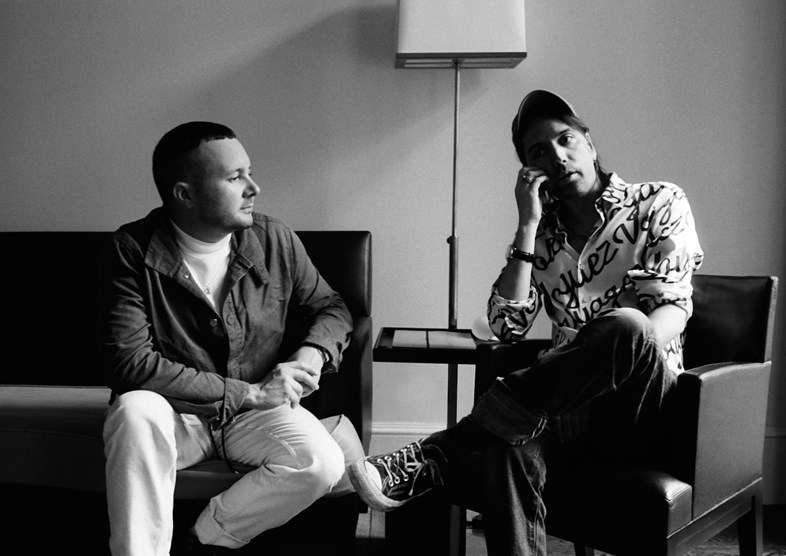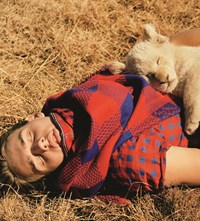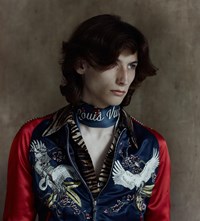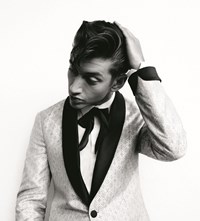In an excerpt from new book Fashion Together, the Louis Vuitton designer and Another Man Creative Director shed light on their working relationship
- TextTed Stansfield
Rick Owens and Michèle Lamy; Shaun Leane and Alexander McQueen; Mert Alas and Marcus Piggot; Vivienne Westwood and Andreas Kronthaler – the history of fashion is littered with examples of extraordinary duos who have worked together to astounding results. These pairings – 18 to be specific – are the subject of a new book titled Fashion Together by Lou Stoppard, published by Rizzoli.
“I felt that collaboration had become such a buzzword in fashion, but that it hadn’t been analysed sufficiently,” Stoppard told Another Man via email. “I wanted to really explore and investigate it – looking closely at some of fashion’s most dynamic and respectd pairs.” One of those relationships is Louis Vuitton’s Artistic Director of Men’s Collections, Kim Jones, and Another Man’s Creative Director, Alister Mackie, who have worked together since Jones was appointed to the role back in 2011.
Here, in an exclusive excerpt from Fashion Together, Jones and Mackie shed light on their working relationship, reveal how they met and what it’s like working on Louis Vuitton.
LOU STOPPARD: Brits in Paris! Is that London sensibility part of your success?
KIM JONES: I think there’s a sensibility in London that works really well in fashion because we’re one of the more open societies – somewhere people will feel a lot of things and be excited about a lot of things. It’s such an international city.
ALISTER MACKIE: It’s historical. People from London have come and done their thing in Paris and broken down that bourgeois theme. I worked at the French house Martine Sitbon when I was young and really absorbed how they approached fashion. They’d be serious about it. Not ironic or mocking at all. It was fascinating to me because I’d come from Dazed & Confused, which was about irony and bucking the system.
LS: Do you remember the first time you met?
KJ: It was on the street in 2000 or 2001. I was with Nicola Formichetti. I think we went to Café de Paris. I can’t really remember the rest of the evening! It did take a bit of time to win you over.
“We have a very similar sense of humour, which is really important” – Kim Jones
AM: I was really close with Nicola, and they were working together. They were on a roll with Kim’s own line, Kim Jones, and they had a dynamic energy together. They were younger than I was and more clubby. It was more sportswear. But Nicola was one of my protégés at the magazine. He’d started to become part of our family, and through that Kim and I got close.
KJ: It did take a while for us to become friendly. He’s quite insular, and I’m a bit more gregarious. But we have a very similar sense of humour, which is really important. Now, I can tell if there’s something Alister would like or hate. He completely understands me and what works for Vuitton and what doesn’t. It’s got that synergy now.
LS: Kim, when you were appointed at Vuitton, did you consider other stylists or did you know straight away that you wanted to work with Alister?
KJ: I called him when I got it straight away. ‘I want you to come work with me.’ And that was it.
AM: It started with a bang. The response was so positive.

KJ: We’d worked together before when I was at Dunhill, and we had a good relationship. The Vuitton team is purely people I trust and like. Alister sees a lot more collections in real life than I do because he’s a stylist, so sometimes he’ll point out things I’m not aware of because I haven’t seen it – a collection looking similar to something recent, or a popular mood. Those things are really important, especially given that there are millions of people watching the show online the moment it happens. The shows are not easy to do, so if you bring someone in to collaborate on them, you have to have that level of trust. And you always have to take the feedback. If you’re successful in a place like Vuitton as a designer, they naturally want more from you, so you have to delegate. We’re doing – I can’t even count! – 12 a collections year, and then there’s all the accessories as well. With the big seasonal runway shows, you’re putting yourself out there every six months. You’re only as good as your last collection.
AM: When I first went to see the shows in Paris in 1994, we were a small group. Only a few people cared and were in that inner circle of the fashion audience. Now, it’s general mass entertainment. Fashion shows have become more and more of a media event. There are so many more people scrutinising it. There are more reviewers, and they’re more outspoken and more public. Now, everybody’s got an opinion. Everybody sees it as soon as it comes out, and everybody’s got something to say, and that’s great, but we are the ones who actually have to do it. We feel the pressure.
“I am perfectly happy being the behind-the-scenes person” – Alister Mackie
LS: Kim, you must feel that even more acutely because you’re the named designer. You’re the one taking the bow at the end.
KJ: I hate being put in the prize picture in the end of the show!
AM: I am perfectly happy being the behind-the-scenes person. I have the best of both worlds, because I’m working on this elaborate runway presentation, but I don’t have to worry about all that stuff that he has to worry about. The production, the sales, the shop opening – stuff like that is not my forte.
LS: Alister, you’re very involved in design, which might surprise people who think a stylist just comes in at the last minute and puts the models in the looks.
AM: I have done that at other houses, but I started at McQueen, and we always worked like Kim and I do. We had training with Lee – fittings and holding the pins, shaking. The fabrics, the colours, the sketch. It was amazing training. Plus, I studied fashion design at Saint Martins.
Fashion Together is out today.















